Walter Aubrey Thomas
Walter Aubrey Thomas (1864, Birkenhead, Cheshire – 1934, Wirral, Cheshire) (also known as Aubrey Thomas) was an English architect who practised from an office in Dale Street, Liverpool. For his training he was articled to the Liverpool architect Francis Doyle, and established his own independent practice in about 1876.[1] His works consisted mainly of commercial buildings. He has been described as "the most individual Liverpool architect of the early 1900s".[2] At least seven of his works are designated by English Heritage as listed buildings, and these are included in the list below, of which the most notable is the Grade I listed Royal Liver Building. Sharples and Pollard in the Pevsner Architectural Guides state that "his work shows admirable inventiveness and stylistic variety, as well as ambition matched by technological resourcefulness".[2]
- For the Liverpool architect with a similar name, see Walter W. Thomas
Key
| Grade | Criteria[3] |
|---|---|
| Grade I | Buildings of exceptional interest, sometimes considered to be internationally important. |
| Grade II* | Particularly important buildings of more than special interest. |
| Grade II | Buildings of national importance and special interest. |
Works
| Name | Location | Photograph | Date | Notes | Grade |
|---|---|---|---|---|---|
| New Zealand House | 18 Water Street, Liverpool 53.4065°N 2.9932°W |
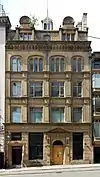 |
c. 1893 | A new commercial building.[4] | — |
| Lord Street Arcade | 81–89 Lord Street, Liverpool 53.4055°N 2.9865°W |
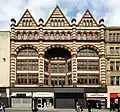 |
1901 | The frontage is in red and white stone in Italian Gothic style. It is in three bays, each bay including a round arch, above which is a row of windows resembling a triforium, and a gable. It originally led to a glass-roofed shopping arcade.[5][6] | II |
| Brooke House | Parkgate, Cheshire 53.2994°N 3.0866°W |
— |
1904 | A house Aubrey Thomas built for himself in "understated" Arts and Crafts style.[7][8] | II |
| State Insurance Building | 14 Dale Street, Liverpool 53.4073°N 2.9901°W |
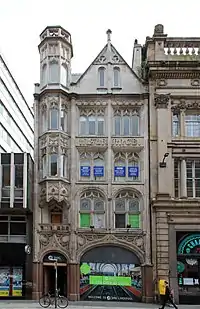 |
1906 | The building was initially symmetrical about a central tower, but it was damaged in the Second World War. The remaining part of the building has three bays, and incorporates a five-storey turret. Its architectural style is described as "flamboyant Gothic", and as "wiry, sinuous Gothic".[9][10][11] | II |
| Tower Building | Corner of Water Street and the Strand, Liverpool 53.4064°N 2.9944°W |
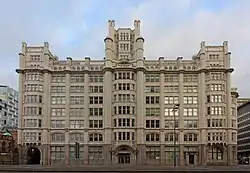 |
1906 | This is an office building on the site of the former Tower of Liverpool, with crenallated turrets providing a link to this. It is one of the earliest steel-framed buildings in the country, and is clad in white glazed terracotta.[4][12][13] | II* |
| Royal Liver Building | Pier Head, Liverpool 53.4058°N 2.9958°W |
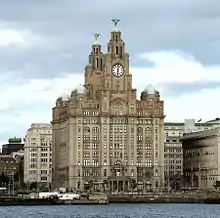 |
1908–11 | This was one of the first multi-storey, reinforced concrete, steel-framed buildings in the world. It was built for the Royal Liver Assurance. Its exterior is cladded with granite. The building is in eight storeys, it incorporates domes at its corners, and has two clock towers, each of which is surmounted by a copper sculpture representing a liver bird. It is described as "perhaps the most extraordinary office block of its date in the country".[14][15][16] | I |
| Crane Building | Hanover Street, Liverpool 53.4044°N 2.9823°W |
 |
1913–15 | This was built as a five-storey store selling musical instruments, with a theatre above it, later known as the Epstein Theatre and the Neptune Theatre. The theatre has been refurbished, and renamed the Epstein Theatre.[17][18][19][20] | II |
| Dunstan Wood | Burton, Cheshire 53.2680°N 3.0169°W |
— |
1926 | A house built by Aubrey Thomas for himself. It is entirely in concrete, including the staircase and the roof.[21] | — |
| Elmhurst | Neston, Cheshire 53.2903°N 3.0684°W |
 |
Undated | Alterations and an extension to a building dating from 1717.[22][23] | II |
References
- Walter Aubrey Thomas (or Aubrey Thomas), Dictionary of Scottish Architects, retrieved 24 November 2012
- Sharples (2004), p. 30
- Listed Buildings, English Heritage, 2010, retrieved 23 September 2012
- Sharples & Pollard (2004), p. 172
- Sharples & Pollard (2004), pp. 30, 154
- Historic England, "81–89 Lord Street, Liverpool (1070625)", National Heritage List for England, retrieved 24 November 2012
- Hartwell et al. (2011), p. 524
- Historic England, "Brooke House, Parkgate (1387784)", National Heritage List for England, retrieved 24 November 2012
- Sharples & Pollard (2004), pp. 145–146
- Pye (2011), p. 84
- Historic England, "State Insurance Building, Liverpool (1068277)", National Heritage List for England, retrieved 24 November 2012
- Pye (2011), p. 76
- Historic England, "Tower Building, Liverpool (1360220)", National Heritage List for England, retrieved 24 November 2012
- Sharples & Pollard (2004), pp. 30, 70–80
- Pye (2011), p. 170
- Historic England, "Royal Liver Building, iron railings and stone piers, Liverpool (1356370)", National Heritage List for England, retrieved 24 November 2012
- Sharples & Pollard (2004), p. 200
- Historic England, "Neptune Theatre, Liverpool (1187370)", National Heritage List for England, retrieved 24 November 2012
- The Epstein Theatre, arthurlloyd.co.uk, retrieved 24 November 2012
- Welcome, Epstein Theatre, retrieved 24 November 2012
- Hartwell et al. (2011), p. 198
- Hartwell et al. (2011), p. 503
- Historic England, "Elmhurst, Neston (1387714)", National Heritage List for England, retrieved 24 November 2012
Bibliography
- Hartwell, Claire; Hyde, Matthew; Hubbard, Edward; Pevsner, Nikolaus (2011) [1971], Cheshire, The Buildings of England, New Haven and London: Yale University Press, ISBN 978-0-300-17043-6
- Pye, Ken (2011), Discover Liverpool, Liverpool: Trinity Mirror Media, ISBN 978-1-906802-90-5
- Sharples, Joseph; Pollard, Richard (2004), Liverpool, Pevsner Architectural Guides, New Haven and London: Yale University Press, ISBN 0-300-10258-5
| Wikimedia Commons has media related to Walter Aubrey Thomas. |